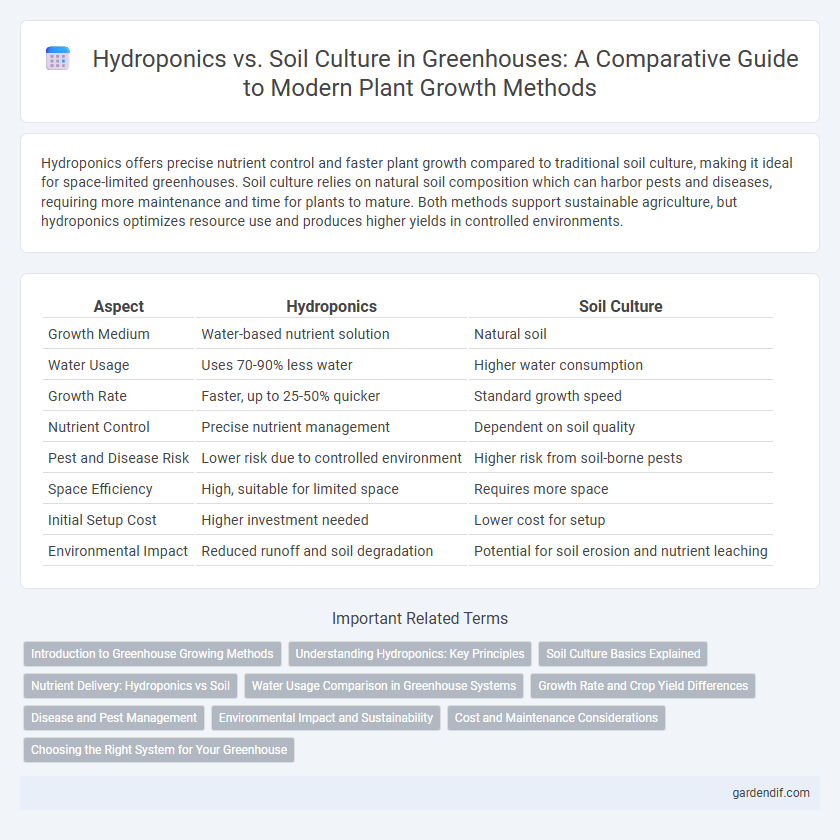
Hydroponics vs Soil Culture Illustration
Hydroponics offers precise nutrient control and faster plant growth compared to traditional soil culture, making it ideal for space-limited greenhouses. Soil culture relies on natural soil composition which can harbor pests and diseases, requiring more maintenance and time for plants to mature. Both methods support sustainable agriculture, but hydroponics optimizes resource use and produces higher yields in controlled environments.
Table of Comparison
| Aspect | Hydroponics | Soil Culture |
|---|---|---|
| Growth Medium | Water-based nutrient solution | Natural soil |
| Water Usage | Uses 70-90% less water | Higher water consumption |
| Growth Rate | Faster, up to 25-50% quicker | Standard growth speed |
| Nutrient Control | Precise nutrient management | Dependent on soil quality |
| Pest and Disease Risk | Lower risk due to controlled environment | Higher risk from soil-borne pests |
| Space Efficiency | High, suitable for limited space | Requires more space |
| Initial Setup Cost | Higher investment needed | Lower cost for setup |
| Environmental Impact | Reduced runoff and soil degradation | Potential for soil erosion and nutrient leaching |
Introduction to Greenhouse Growing Methods
Hydroponics and soil culture represent two primary greenhouse growing methods with distinct advantages for crop production. Hydroponics uses nutrient-rich water solutions to grow plants without soil, offering precise control over nutrition and faster growth rates. Soil culture relies on traditional soil mediums, supporting natural microbial activity and often requiring less technological input but potentially slower growth compared to hydroponic systems.
Understanding Hydroponics: Key Principles
Hydroponics relies on growing plants in nutrient-rich water solutions without soil, allowing precise control over nutrient delivery and environmental conditions. Essential principles include maintaining optimal pH levels, oxygenation of roots, and balanced nutrient concentrations to promote faster growth and higher yields. Understanding these factors enables efficient resource use and reduces the risk of soil-borne diseases compared to traditional soil culture.
Soil Culture Basics Explained
Soil culture in greenhouse gardening involves growing plants directly in nutrient-rich soil that provides essential minerals, organic matter, and beneficial microorganisms supporting plant growth. It enables natural root development and better water retention compared to hydroponics, making it ideal for crops requiring stable soil structure and microbial activity. Understanding soil composition, pH balance, and proper aeration is critical for optimizing plant health and maximizing yield in soil culture systems.
Nutrient Delivery: Hydroponics vs Soil
Hydroponics delivers nutrients directly to plant roots through a precisely controlled water-based solution, ensuring optimal absorption and faster growth compared to traditional soil culture, where nutrients must be extracted from the soil matrix, often leading to variable nutrient availability. In hydroponic systems, the concentration of essential elements like nitrogen, phosphorus, and potassium is continuously monitored and adjusted, minimizing nutrient wastage and deficiencies. Soil culture relies on organic matter decomposition and microbial activity to release nutrients, which can result in slower and less efficient nutrient uptake.
Water Usage Comparison in Greenhouse Systems
Hydroponics in greenhouse systems uses up to 90% less water compared to traditional soil culture by recycling nutrient solutions and minimizing evaporation. Water efficiency is enhanced through precise delivery directly to plant roots, reducing runoff and wastage. Soil culture relies on larger volumes of water due to absorption, drainage, and evaporation, resulting in lower water-use efficiency.
Growth Rate and Crop Yield Differences
Hydroponics accelerates plant growth rates by providing nutrient-rich water directly to roots, enabling faster nutrient absorption compared to soil culture. Crop yields in hydroponic systems are typically higher, with some studies showing up to a 25-50% increase due to controlled environments and optimized nutrient delivery. Soil culture, while less efficient, offers benefits in flavor complexity and microbial ecosystem support but generally results in slower growth and lower yields.
Disease and Pest Management
Hydroponics offers a controlled environment that significantly reduces soil-borne diseases and pest infestations common in traditional soil culture, promoting healthier plant growth. The absence of soil eliminates many pathogens and pests that thrive in soil, enabling easier monitoring and targeted interventions. Integrated pest management in hydroponics can be more efficient due to precise nutrient and water delivery, reducing the use of harmful pesticides.
Environmental Impact and Sustainability
Hydroponics significantly reduces water consumption by up to 90% compared to traditional soil culture, promoting resource efficiency and minimizing runoff pollution. The closed systems in hydroponic setups decrease pesticide use and prevent soil degradation, supporting sustainable agriculture practices. Conversely, soil culture can lead to soil erosion and nutrient depletion, posing long-term environmental challenges for greenhouse farming.
Cost and Maintenance Considerations
Hydroponics systems typically require higher initial investment due to specialized equipment like pumps, reservoirs, and nutrient solutions, whereas soil culture tends to have lower startup costs with simpler tools and readily available soil. Maintenance in hydroponics involves regular monitoring of water quality, nutrient balance, and system cleanliness to prevent diseases, leading to potentially higher ongoing labor and expertise costs compared to soil culture's focus on soil fertility management and pest control. Over time, hydroponics can reduce expenses related to water usage and fertilizer runoff, offering efficiency advantages despite the demand for precise system management.
Choosing the Right System for Your Greenhouse
Hydroponics offers faster plant growth and higher yields by delivering nutrient-rich water directly to roots, ideal for controlled greenhouse environments and space optimization. Soil culture provides natural microbial benefits and improved plant resilience but requires more space and is prone to soil-borne diseases, making it suitable for traditional greenhouse setups with ample room. Choosing the right system depends on greenhouse size, crop type, resource availability, and desired production efficiency.
Hydroponics vs Soil Culture Infographic

 gardendif.com
gardendif.com